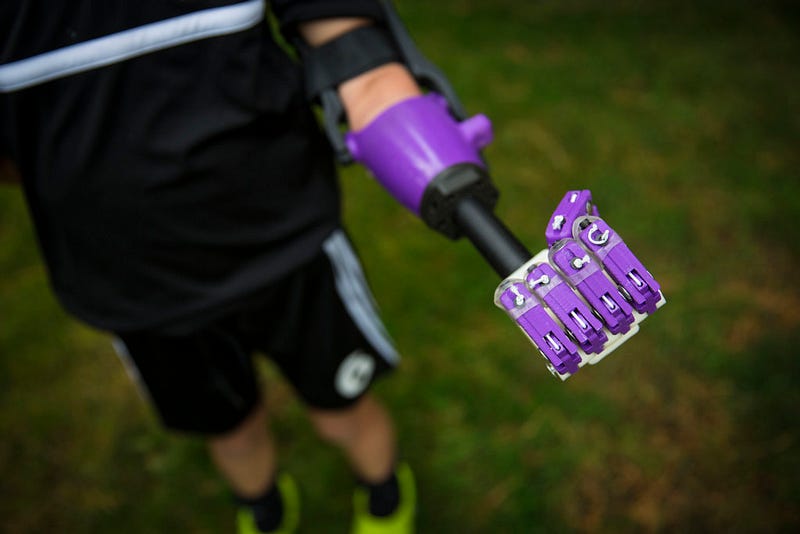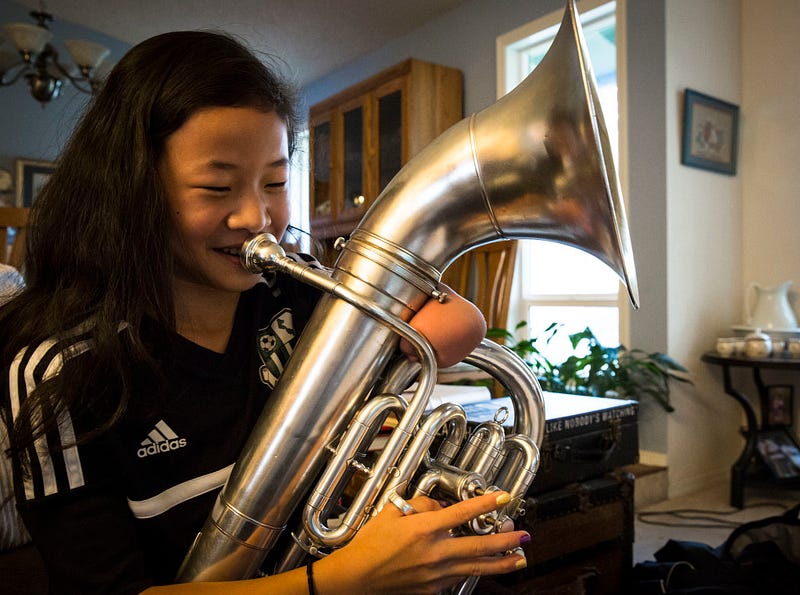A Helping Hand
A 12-year-old girl and high school robotics team create opportunity for the Whidbey Island community
STORY AND PHOTOS BY MADELINE TAKATA
(Above) Jaelyn and her sister Kaia may be only three months apart, but the two are different in many ways. Both adopted separately from China, Kaia is the oldest out of the two.
JAELYN
Jaelyn Crebbin stands behind the screen door as her mom, Toni, opens up their Whidbey Island home. The 12-year-old Chinese girl stands smiling dressed in her black select soccer uniform. She scurries onto the couch cozying up in the corner. She props herself up with her knees pulled into her chest and a big smile on her face.
Jaelyn is an average sixth grade girl. In between school and sports, she has a passion for animals, plays the baritone and passes time by drawing while listening to Katy Perry. However, Jaelyn is unique. She was born without a left arm. Jaelyn can ride a bike, swim, tie her shoes and play sports solely relying on her right arm. Although this never stopped Jaelyn from accomplishing anything she faced, a gift from Whidbey Island’s Oak Harbor High School robotics team is making life a little easier.
Jaelyn now sports a purple, plastic prosthetic arm built custom for her in a 3-D printer by the robotics team.
“Having a purple arm makes her feel more normal,” Toni says. “She walks down the school hallways with a smile and people are excited to see it.”
Jaelyn proudly shows off her two arm models. One is a purple arm with a hand that opens and closes at the bend of her elbow and the other a pink arm that is built to hold a trumpet because she wants to learn how to play.
Jaelyn sits giggling on the couch shrugging her shoulders at the questions being asked, unaware at how truly remarkable she is. Her independence from a young age has built a character of self-sufficiency, determination and a light hearted nature that has grown from a disability to ultimate strength.

Amidst conversation Jaelyn gets ready for her soccer game, putting on her shin guards, soccer socks and shoes using a one-handed technique she has developed. She says putting up her hair is still a challenge. Jaelyn chooses to play soccer without her prosthetic, because she is becoming more acquainted with her new addition. Right now she is learning how to grasp things better, balance what she’s holding and reach for items.
At her soccer game Jaelyn fearlessly takes the field, outrunning the other players. She is the first to throw in the ball from the sideline, relying on her one arm, and sits eagerly waiting to be called back into the game.
Keeping up with the other kids has never been a worry for Jaelyn or her family.
“I didn’t have too many concerns for Jaelyn when she was growing up,” Toni says. “When we adopted her she was already so independent.”
The Crebbins adopted Jaelyn in 2003 when she was two years old from Jilin, a northern province in China after adopting another girl Kaia, 11, the year before.
Kaia and Jaelyn are only three months apart, making them virtual twins and inseparable sisters. Along with Jaelyn and Kaia, the Crebbins have two biological sons; Kellen, 24 and Joshua, 21.
Toni and her husband Mike, who are both teachers, remember feeling a spiritual call to adopt children who struggled with a physical difference. Kaia was born with a cleft lip meaning her upper lip and mouth palate were not fully developed, which left openings. When Toni and Mike brought her home Kaia went through several medical procedures to repair her lip and pallet. For their second adoption, they found Jaelyn, who was at the time in an orphanage after being found at the gate of a nursing home as an infant. Toni, Mike and their two biological sons went to China and remember being at awe of Jaelyn’s self-sufficiency.
Although Jaelyn is extremely independent and confident, the inevitable extra attention that comes with her differences is bound to happen.
“When I’m in public, people would just stare at my arm,” Jaelyn recalls. “People would stare, little kids would ask questions and touch it.”
Toni and Mike approached the public’s responses in a lighthearted way, teaching Jaelyn how to respond appropriately.
“We tried to empower Jaelyn,” Toni says. “She kept a good humor about it and would respond maturely, encouraging people to simply ask and she would explain.”
Toni and Mike always let Jaelyn take the lead on what she wanted to do. They never pressed a prosthetic but left it as an option for her if she wanted one.
Jaelyn never expressed interest in one until she saw her friend Will (whom she was connected with from an online limb disability support group) from Florida receive a prosthetic from an organization called e-NABLE.
Founded in 2013, e-NALBE is a volunteer based nonprofit organization created by a research scientist at Rochester Institute of Technology. e-NABLE is a web-based community linking thousands of volunteers globally whom by using 3-D printers, design skills and personal time, create prosthetic hands and arms, according to the e-NALBE website. The organization reaches 37 countries around the world and has printed about 1,500 arms for those in need.
THE TEAM
The Oak Harbor Robotics team became a part of the e-NABLE network and sought out Jaelyn around the same time her interest for a prosthetic arm began to grow.
Che Edoga, the Oak Harbor robotics team instructor, applied for a grant to receive a 3-D printer. After a process of two years, the team began constructing prosthetics arms based on designs sent from e-NABLE.
With materials costing $30, the team measured, fit and created an arm for Jaelyn. It’s been a trial and error process for the team. The first model they created for Jaelyn was too long, so they went back and created a second version with rotating hand and shorter forearm.
Oak Harbor senior, Michael Uttmark, had been heading the design and construction process for Jaelyn. At only 17 years old, Michael is designing his own models using complex 3-D printer programs where he has been creating different prototypes for Jaelyn. After he takes her measurements, Michael thinks about what he wants to design, sketches it out and then begins building it in the model program, Autodesk Inventor.
From there, the design is sent to the 3-D printer where it will print three-dimensional solid parts ready for assembly.
“At its heart, 3D printing is like playing with a glue gun,” Michael says. “Except, the glue is molten plastic, and you are a computer with complex software.”
Using e-NABLE’s designs for inspiration, Michael has been spending hours designing a new active arm model for Jaelyn that will be responsive to her muscle measurements. By using an electromyography sensor, the arm will evaluate the electrical activity produced by skeletal muscles, Michael says. The prosthetics she has now are passive, which means they work based on simple joint moments such as bending her arm.
“I remember being told that you can either choose robotics, academics or sleep,” Michael says. “I decided to choose academics and robotics.”

This entire process is big for the Crebbins, but Toni says is even bigger for the community.
“Receiving this arm has been great for Jaelyn, but it’s motivating the students to learn, and they have already created arms for two other kids in the area,” Toni says.
With the condition being only found in 1 out of every 20,000 people, the robotics’ team hope that word will soon get off the island and more people will begin reaching out since they are the only high school robotics team producing prosthetics.
“Robotics isn’t about the robot,” Michael says. “The robot is the means to learn things you can use to help the community.”
Looking forward, Jaelyn is excited to see what the robotics team has in store. Now a bit of a local celebrity, she is becoming the poster child for this new technology with a video of her trying out her new arm getting over 1,000 shares on Facebook and inspiring other families to look into prosthetics as a feasible option.
Although she is gaining attention, to Jaelyn, she is just like every other eleven-year-old girl.
“People are seeing how self confidant she is and how positively this is influencing her life,” Toni says. “She doesn’t even realize she is a role model.”
